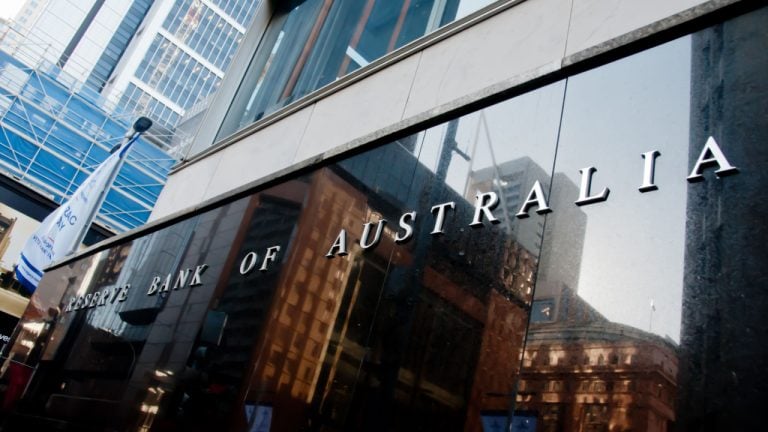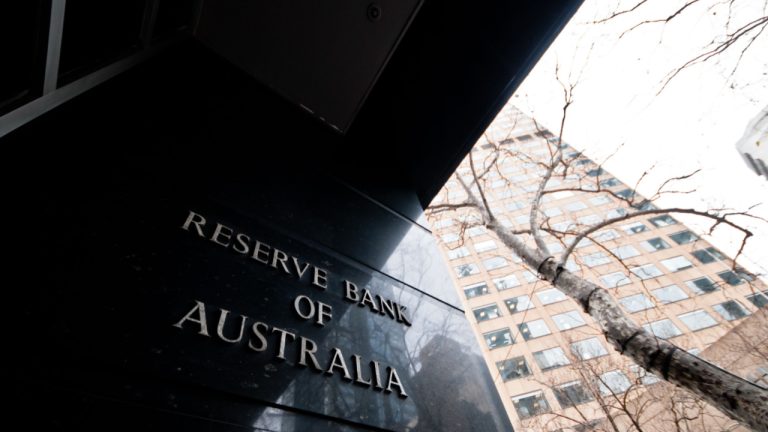
Australia’s central bank and banknote issuing authority is pursuing initiatives on central bank digital currency (CBDC) and digital money. According to Reserve Bank of Australia (RBA) assistant governor Brad Jones, the central bank’s work agenda on digital money will focus more on wholesale CBDC used by banks and other financial institutions than on retail CBDC […]
The post Australian Reserve Bank Has ‘Strategic Commitment’ To Develop CBDC System, According to Assistant Governor appeared first on The Daily Hodl.

The move comes as Australians continue to reduce their usage of cash and bank branches, but has sparked fears that the death of cash is near.
ANZ, one of Australia’s “Big Four” banks, will cease facilitating withdrawals and deposits from a number of its Australian branches as it looks to push its customers toward using an ever-dwindling number of ATMs and deposit machines.
The decision has received pushback, with critics such as Patricia Sparrow, CEO of the Council on the Ageing, telling The Australian that the change could disproportionately affect older people who are less capable of going digital. Others have suggested it would make fiat users more susceptible to technical issues. The move has also renewed fears of a push to eliminate cash and that cash could soon be replaced by central bank digital currencies (CBDCs).
The end of cash is near.
— Wall Street Silver (@WallStreetSilv) March 29, 2023
They are trying to go all digital, and then bring in the Central Bank Digital Currency (CBDC) to be programable so they can control how you spend your money.
Eventually they will be able to make your CBDC money expire or disallow certain products. pic.twitter.com/8O27nn4iYe
In response to questions from Cointelegraph, an ANZ spokesperson said that the affected branches are all metropolitan branches that have ATMs and deposit machines nearby and that the move was partially prompted by in-branch transactions decreasing by more than 50% over the past four years.
The development comes as Australia gradually transitions to a cashless society, with the percentage of retail payments made with cash falling from 59% in 2007, to just 27% in 2019, according to a March 16 bulletin from the Reserve Bank of Australia (RBA).
The RBA noted that the results from its 2022 survey will be available later this year, but added that the COVID-19 pandemic had only accelerated the trend, with businesses also contributing to the shift:
“Furthermore, a substantial share of merchants indicated plans to discourage cash payments at some point in the future.”
The RBA also pointed to a reduction in ATMs and bank branches around the nation, with the number of bank branches falling by 30% since 2017 while ATMs numbers fell by 25% since 2016.
One of the major concerns with CBDCs replacing cash is how they might affect individual freedom and privacy, as cash transactions offer anonymity and the ability to make transactions without leaving a record.
A CBDC pilot program is currently underway in Australia, with an update expected around the middle of 2023, and one of the ramifications identified by the RBA was that it could displace the cash Australian dollar.
Related: Ted Cruz and Ron DeSantis take on the ‘digital dollar’: Law Decoded, March 20–27
In an emailed response to questions from Cointelegraph, a spokesperson for another of the Big Four banks, NAB, allayed these fears somewhat, saying:
“NAB still handles cash at our branches and we have no plans to change. Cash will continue to play an important part in Australian society for as long as our customers want it to.”
The other two banks in the Big Four, CBA and Westpac, did not respond to questions from Cointelegraph by the time of publication, but Westpac told The Australian that it also had no plans to wind back access to cash through its branches. A CBA spokesperson was slightly more ambiguous in their response, however.
Asia Express: US and China try to crush Binance, SBF’s $40M bribe claim

This marks the second "Big 4" bank in Australia to launch an Australian-dollar pegged stablecoin in a bid to boost the digital economy.
National Australia Bank (NAB) is set to become the second “Big 4” Australian bank to launch an Australian dollar-pegged stablecoin on the Ethereum network.
Set to launch sometime in mid-2023, the AUDN stablecoin is aimed at streamlining cross-border remittances and carbon credit trading, according to a Jan. 18 report from the Australian Financial Review (AFR).
NAB’s chief innovation officer Howard Silby said the decision to mint the AUDN stablecoin on Ethereum — which is backed 1:1 by the Australian dollar (AUD) — was based on their belief that blockchain infrastructure will play a key role in the next evolution of finance:
We certainly believe there are elements of blockchain technology that will form part of the future of finance [...] From our point of view, we see [blockchain] has the potential to deliver instantaneous, transparent, inclusive, financial outcomes.”
The implementation of AUDN for real-time, cross-border remittances could become a way for customers to sidestep the slower and more costly SWIFT payment network.
Carbon credit trading and other forms of tokenzied real-world assets will also be a major use case for the AUDN, Silby said. He also added that they’re planning to offer stablecoins in “multiple currencies” where the bank has licenses.
NAB’s announcement of the AUDN comes nine months after rival bank Australia and New Zealand Banking Group (ANZ) launched 30 million tokens of its own stablecoin tickered A$DC in March 2022, which is also used for international remittances and carbon trading.
Prior to ANZ and NAB’s stablecoin projects, the two banks initially planned on teaming up with the other two “Big 4” Australian banks — Commonwealth Bank of Australia (CBA) and Westpac — to co-launch a nationwide stablecoin backed by the AUD.
However, it failed due to competition concerns and the banks being at different stages in their adoption and strategy, the AFR explained.

Jonathon Miller, Australia’s managing director of crypto exchange Kraken Australia told Cointelegraph that banks are beginning to acknowledge the technical advantages that blockchain infrastructure offers over traditional legacy systems:
“The persistent adoption of crypto technology by financial institutions like ANZ and now NAB for its potential to create significant efficiencies in the financial system [...] is an explicit recognition of [blockchain’s] competitive advantage over traditional payment systems.”
“We expect this trend to continue, inevitably evolving to include the adoption of various other cryptocurrencies and tokens for increasing use cases in the Australian economy,” he added.
Related: Stablecoin framework is a near-term priority for Aussie regulators
It also remains to be seen how these private bank-issued stablecoins would work in tandem with the Reserve Bank of Australia’s eAUD — a central bank digital currency (CBDC) — which is currently in its pilot phase.
However, NAB is confident the two will be able to operate simultaneously and have their own set of unique use cases.
 Reserve Bank of Australia is researching the potential benefits of launching a central bank digital currency. The monetary authority released a white paper outlining its goals and invited interested parties to participate with proposals and suggest pilot projects. Central Bank of Australia to Pilot CBDC Until Middle of 2023 The Reserve Bank of Australia (RBA) […]
Reserve Bank of Australia is researching the potential benefits of launching a central bank digital currency. The monetary authority released a white paper outlining its goals and invited interested parties to participate with proposals and suggest pilot projects. Central Bank of Australia to Pilot CBDC Until Middle of 2023 The Reserve Bank of Australia (RBA) […] The monetary authority in Australia is beginning research into the potential economic benefits of issuing a central bank digital currency. Within the project, the regulator hopes to identify use cases and intends to develop a limited-scale pilot. Central Bank of Australia Working on Digital Currency Program The Reserve Bank of Australia (RBA) announced the launch […]
The monetary authority in Australia is beginning research into the potential economic benefits of issuing a central bank digital currency. Within the project, the regulator hopes to identify use cases and intends to develop a limited-scale pilot. Central Bank of Australia Working on Digital Currency Program The Reserve Bank of Australia (RBA) announced the launch […]
The Reserve Bank of Australia has warned local investors that the speculative frenzy on crypto could soon dry up if policymakers and regulators step in.
The Reserve Bank of Australia (RBA) has warned Aussie investors about speculating on digital assets as it casts doubt over the entire crypto sector.
During a Nov. 18 address to the Australian Corporate Treasury Association, the RBA’s head of payments policy Tony Richards offered an overview on distributed ledger tech, crypto assets, stablecoins, and central bank digital currencies (CBDCs).
In his speech, Richards raised questions over crypto’s validity and growth in 2021 as he took aim at the amount of capital invested into memecoins such as Dogecoin (DOGE) and Shiba Inu (SHIB):
“The recent boom in this area is perhaps best illustrated by the fact that Dogecoin, a cryptocurrency that was started as a joke in late 2013, had an implied market capitalization as high as US$88 billion in June this year.”
“And the Shiba Inu token, which appears to be equally free of any useful function, is currently the ninth-largest cryptocurrency, with a market capitalization of around US$26 billion,” he added.
Richards also asserted that public attention captured by crypto in 2021 was “no doubt fueled by influencers and celebrity tweets,” as he refuted the reported scope of how widespread crypto adoption really is in the country.
“Some surveys have claimed that around 20 percent of the Australian population hold cryptocurrencies, and one claimed that Dogecoin alone was held by 5 percent of Australians. I must say that I find these statistics somewhat implausible,” he said.
Richards outlined three scenarios in which the “current speculative demand could begin to reverse” in crypto that would essentially leave digital assets with minimal use cases in his opinion.
Firstly, he argued that investors may soon “be less influenced by fads” and FOMO and instead pay more attention to warnings of regulators and policymakers.
Secondly, he said that governments across the globe may aim to crack down on energy-intensive proof-of-work-based cryptocurrencies such as Bitcoin (BTC), and finally he said the tax authorities may aim to remove anonymity to clamp down on financial crime.
Related: Aussie crypto companies keen to embrace regulations, says senator
Commenting on Richards’ address, Steve Vallas the CEO of Blockchain Australia refuted the speculative-focused arguments against the entire sector, telling Cointelegraph that:
“Some regulators maintain an unhelpful and narrow focus on the speculative elements of the sector. That lens misses the remarkable infrastructure build that has occurred in recent years.”
A disappointing view in the face of a global opportunity to lead for Australia.
— Blockchain Australia (@BlockchainAUS) November 18, 2021
"RBA warns of ‘faddish’ crypto crash" https://t.co/9AIGlwmNoc via @eyersj @jessicasier
Crypto-friendly Senator Andrew Bragg, who is one of the key politicians behind the push to introduce robust crypto regulations in Australia echoed similar sentiments, noting that “the RBA is short-sighted on cryptocurrency. The utility and value to the economy of the technology is enormous.”